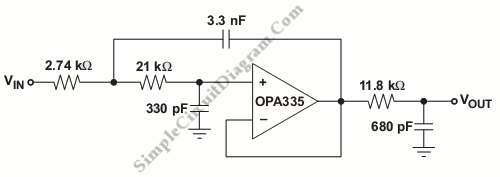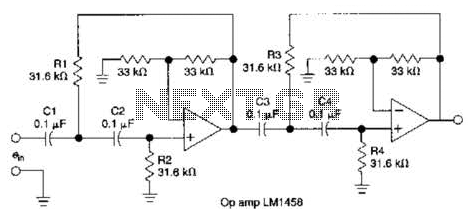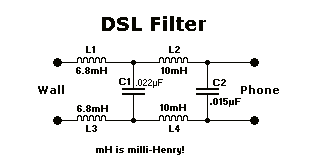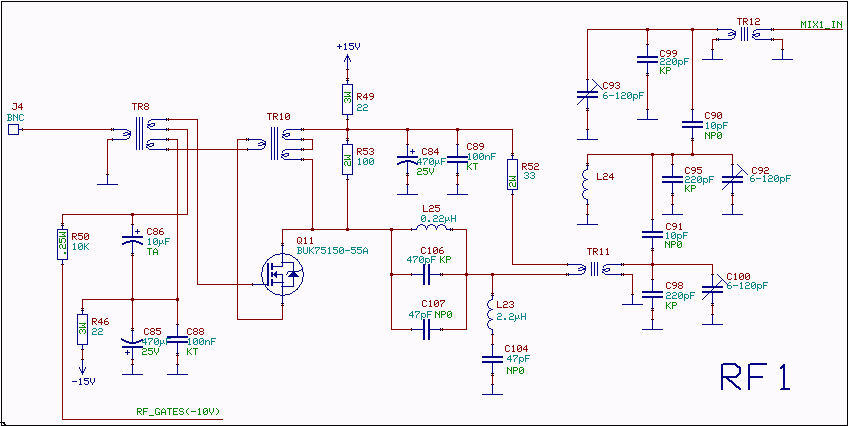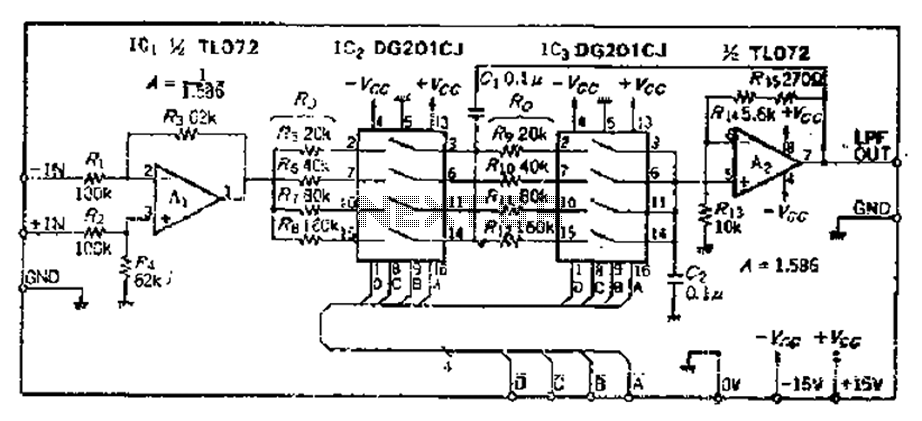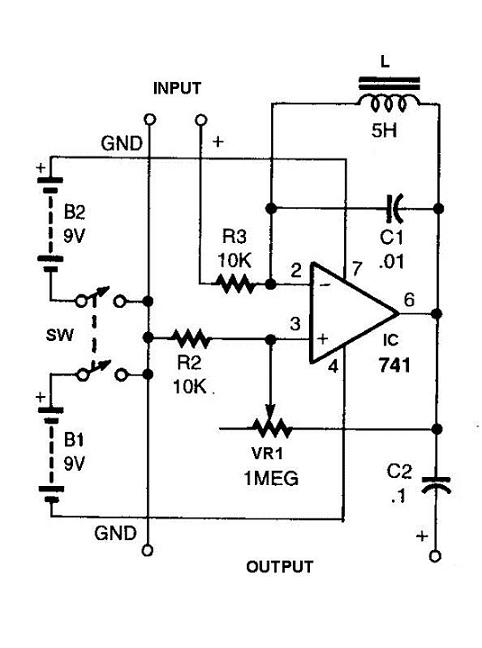
BCI Filter
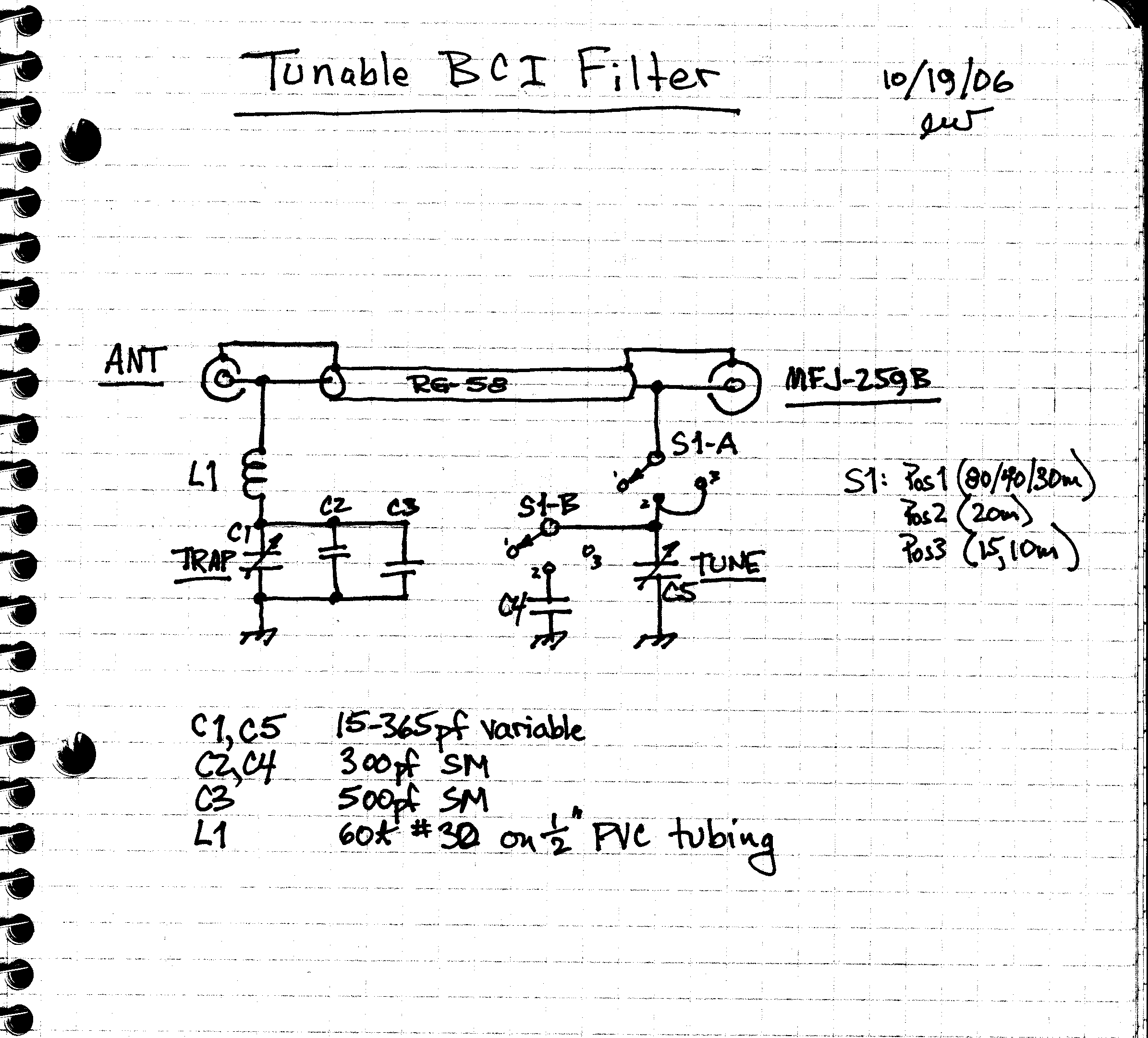
The design involves creating an AM broadcast signal eliminator. An undesired AM broadcast signal is directed to ground using a series resonant circuit composed of inductor L1 and capacitors C1, C2, and C3. At high frequencies, this series circuit presents itself as an inductor from the input to ground. To form a parallel resonant circuit at the operational frequency of the designed antenna, a variable capacitor made from combinations of C4 and C5 is added across the series resonant circuit. The entire assembly is housed in a large outlet box, although an aluminum enclosure from Radio Shack is recommended for easier modification. L1 consists of approximately 50 microhenries, achieved by winding 60 turns of #30 wire around a 1-inch outer diameter, 2-inch long PVC tube. Capacitors C1 and C5 are variable air capacitors ranging from 15 to 365 picofarads, while C2 and C3 can be combined to achieve a total capacitance of 800 picofarads. Capacitor C4 is switched in to accommodate 15m and 10m bands. Although layout is not critical, minimizing lead lengths is advisable. This prototype functioned well without further refinements. A suggestion is made to replace switch S1 with a pair of toggle switches for improved functionality. The tunable filter's input should connect to an Antenna Analyzer, with the output linked to the antenna. The analyzer should be tuned to the antenna's operating frequency, and C1 adjusted for the lowest standing wave ratio (SWR) reading, effectively nullifying the AM broadcast signal. After applying a 50-ohm load to the filter's output connector, C5 should be adjusted to achieve 50 ohms with zero reactance, enabling accurate antenna measurements without interference from the AM broadcast signal.
The AM broadcast signal eliminator circuit is designed to effectively filter out unwanted AM signals, allowing for more accurate antenna measurements. The series resonant circuit comprising L1 and capacitors C1, C2, and C3 is critical in shunting the undesired signals to ground. The selected inductor, L1, with approximately 50 microhenries, is constructed using a specific number of turns of wire, which influences the inductance value and the circuit's overall performance. The variable capacitors C1 and C5 enable fine-tuning of the resonant frequency, allowing the user to adapt the circuit to various operational frequencies of different antennas.
The inclusion of capacitors C2 and C3, which can be combined to achieve a higher total capacitance, adds flexibility to the circuit design. The use of an aluminum enclosure for housing the circuit is beneficial due to its ease of modification and durability, which is essential for practical applications.
The tuning process involves connecting the circuit to an Antenna Analyzer, which is a crucial step in ensuring that the circuit performs as intended. By adjusting C1 to achieve a minimum SWR reading, the user can effectively nullify the AM broadcast signal, allowing for clearer measurements. The subsequent adjustment of C5 ensures that the output impedance is matched to 50 ohms, which is standard for most RF applications, thereby optimizing performance.
Overall, this circuit serves as a valuable tool for amateur radio operators and anyone involved in antenna design and testing, providing a means to eliminate interference from AM broadcast signals and enhance measurement accuracy.Designing and building an AM Broadcast Sucker-outer. The undesired AM broadcast signal is shunted to ground with a series resonant circuit consisting of L1 and C1, C2, and C3. At the HF frequencies, this series circuit will look like an inductor from Input to ground, so I put a variable capacitor (various combinations of C4 and C5) across the series resonant circuit to create a parallel resonant circuit at the
operating frequency of the antenna being designed. The entire circuit is built in a large outlet box, but I`d recommend using an aluminum enclosure from Radio Shack because it`s much easier to drill holes in. L1 is about 50 microhenries (not critical), which is 60 turns of #30 wire on a piece of PVC tubing that`s 1 inch OD, by 2 inches long.
C1 and C5 are 15 - 365pf air variables. C2 and C3 can be combined for a total of 800pf. C4 is switched in to cover 15m and 10m. Layout is not critical, but short lead lengths are always a good idea. This was a prototype that worked, so I never bothered to clean up the design. I think replacing S1 with a pair of toggle switches might be a good improvement. Connect the tunable filter Input to your Antenna Analyzer, and the Output of the filter to the antenna. Tune the analyzer to the operating frequency of the antenna, and adjust C1 for a minimum "SWR" reading.
In doing this, you are nulling the AM broadcast signal. Now put a 50 ohm load on the Output connector of the filter, and adjust C5 for 50 ohms with zero reactance. You are now ready to make antenna measurements without that pesky AM Broadcast signal driving your Antenna Analyzer crazy.
If you have any questions or suggestions for improvement of this circuit, please let me know. This was a project that wasn`t on the list when I wanted to tune my 40m Inverted Vee, and I didn`t stop to make improvements. 🔗 External reference
The AM broadcast signal eliminator circuit is designed to effectively filter out unwanted AM signals, allowing for more accurate antenna measurements. The series resonant circuit comprising L1 and capacitors C1, C2, and C3 is critical in shunting the undesired signals to ground. The selected inductor, L1, with approximately 50 microhenries, is constructed using a specific number of turns of wire, which influences the inductance value and the circuit's overall performance. The variable capacitors C1 and C5 enable fine-tuning of the resonant frequency, allowing the user to adapt the circuit to various operational frequencies of different antennas.
The inclusion of capacitors C2 and C3, which can be combined to achieve a higher total capacitance, adds flexibility to the circuit design. The use of an aluminum enclosure for housing the circuit is beneficial due to its ease of modification and durability, which is essential for practical applications.
The tuning process involves connecting the circuit to an Antenna Analyzer, which is a crucial step in ensuring that the circuit performs as intended. By adjusting C1 to achieve a minimum SWR reading, the user can effectively nullify the AM broadcast signal, allowing for clearer measurements. The subsequent adjustment of C5 ensures that the output impedance is matched to 50 ohms, which is standard for most RF applications, thereby optimizing performance.
Overall, this circuit serves as a valuable tool for amateur radio operators and anyone involved in antenna design and testing, providing a means to eliminate interference from AM broadcast signals and enhance measurement accuracy.Designing and building an AM Broadcast Sucker-outer. The undesired AM broadcast signal is shunted to ground with a series resonant circuit consisting of L1 and C1, C2, and C3. At the HF frequencies, this series circuit will look like an inductor from Input to ground, so I put a variable capacitor (various combinations of C4 and C5) across the series resonant circuit to create a parallel resonant circuit at the
operating frequency of the antenna being designed. The entire circuit is built in a large outlet box, but I`d recommend using an aluminum enclosure from Radio Shack because it`s much easier to drill holes in. L1 is about 50 microhenries (not critical), which is 60 turns of #30 wire on a piece of PVC tubing that`s 1 inch OD, by 2 inches long.
C1 and C5 are 15 - 365pf air variables. C2 and C3 can be combined for a total of 800pf. C4 is switched in to cover 15m and 10m. Layout is not critical, but short lead lengths are always a good idea. This was a prototype that worked, so I never bothered to clean up the design. I think replacing S1 with a pair of toggle switches might be a good improvement. Connect the tunable filter Input to your Antenna Analyzer, and the Output of the filter to the antenna. Tune the analyzer to the operating frequency of the antenna, and adjust C1 for a minimum "SWR" reading.
In doing this, you are nulling the AM broadcast signal. Now put a 50 ohm load on the Output connector of the filter, and adjust C5 for 50 ohms with zero reactance. You are now ready to make antenna measurements without that pesky AM Broadcast signal driving your Antenna Analyzer crazy.
If you have any questions or suggestions for improvement of this circuit, please let me know. This was a project that wasn`t on the list when I wanted to tune my 40m Inverted Vee, and I didn`t stop to make improvements. 🔗 External reference
